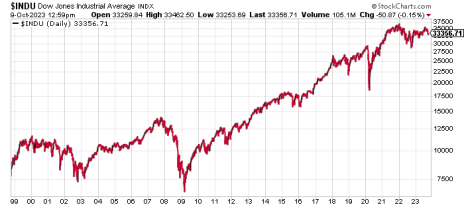Looking back at the Dow Jones Industrial Average over the past 25 years, it’s easy to see that the most reliable path to wealth—and our golden years—is by investing in the stock market. Since 1998, the DJIA has gained 322%.
But as you can see from the chart below, there have been some hair-raising moments along the way, including:
* A drop of 37% from March 2002 until September 2002
* 20% lost between April 1998 and August 1998
* A 36% decline from February to March of 2020
*20% lost in the first nine months of 2022
* And of course, the granddaddy of them all, the decline of 54% between October 2007 and March 2009.
During periods of volatility, investors who took measures to protect their portfolios were the real winners. Sure, they may have lost some money when their shares began dropping, but they also were ready to buy back in after the shares had bottomed out, setting them up for some fantastic future gains.
[text_ad]
Investors who “bought and held,” undoubtedly, had many sleepless nights. And depending on the stocks they purchased, they may have lost a bunch of money—money that may never be recovered. Others may have lucked out, hanging onto companies whose shares eventually gained back their losses. Whichever the scenario, I know one thing—the angst and uncertainty is just not worth deploying the buy-and-hold strategy.
You see most investors make one big mistake: They love to buy stocks and they hate to sell them. When the market looks enticing, they become so excited that they begin to buy stocks, willy-nilly, with no thought to a balanced portfolio. And when the market drops, they become frozen, not knowing whether they should continue to buy more to take advantage of the lower prices or just bail out and sell everything. And the sad result is usually this: When under pressure, investors will generally make exactly the wrong decision!
In essence, they fail to plan.
But you don’t have to make the same mistakes. Instead, with a little thought and planning, you can protect your portfolio.
Now, I’m not saying you won’t ever lose money, because there are no guarantees in the stock market. But there are steps you can take to minimize your losses and also maximize your profits.
5 Steps to Protect Your Portfolio
1. Set a price target the day you purchase your stocks. Your target should be based on the P/E of your stock, multiplied out by expected future earnings. I recommend that you at least think about what price your stock can achieve within 18-24 months. And that should at least be a 30%-50% gain. If it doesn’t have that potential, keep looking.
Going forward, when the stock hits your target, reevaluate it and determine if it has the ability to continue double-digit price gains or if you would gain more by cashing in now and using those funds to purchase a different stock with more potential. My advice: When a stock hits my first target—even if it still has some oomph left, I like to cash in one-half of my holdings, and let the remaining half ride toward my new target. This will help you capture gains, protect your portfolio, and it frees up cash for your next trade.
2. Set a stop-loss limit the day you purchase your stocks. For aggressive investors, the stop-loss could be 30% or more. For more conservative investors, you might be happier with a stop-loss of 10%. The actual percentage is not as important as being disciplined in exercising the stop losses and protecting your portfolio. Sure, no one likes to lose money, but a stock riding momentum down can clean you out in no time, so it’s best to take your losses. If the stock bounces back, you can always buy back into it.
3. Diversify your portfolio to reduce your overall portfolio risk, as well as volatility. That means creating a portfolio with non-correlated assets, which, theoretically, results in assets that react differently to market catalysts. When market action causes some of your assets to decline in value, others should rise, effectively protecting your portfolio assets from all declining at the same time.
Consequently, you should own small-, mid- and large-cap stocks; companies in different sectors; and value and growth stocks. You should also have exposure to international stocks, either through owning multinational companies or via exchange-traded funds. And don’t forget about fixed income investments. Some investors may want to add currencies, commodities, and real estate to their portfolios.
The actual composition of your portfolio will depend on your personal investment goals, your age, and your risk profile. You might want to take an investor risk profile quiz, such as this one offered by Charles Schwab, to help you determine your portfolio strategy.
4. Put some dividend-paying stocks in your portfolio. They are a great hedge against inflation and provide terrific portfolio gains in down market cycles. Years ago, during the tech boom, I began adding dividend stocks, such as regional banks and Real Estate Investment Trusts to my portfolio. The payoff was great! When the tech stocks hit the dust and the market took a downturn, I was still earning some great returns on my dividend stocks. Many investors neglect these companies as they think they are too boring. But, what’s boring about making money?
5. Consider buying put options as insurance that any unrealized gains you have don’t turn into losses. These options provide protection by betting that the underlying stock will decline. They give you the right (not the obligation) to sell the stock at a certain price at a specific future time.
Most investors don’t use options, because they can be expensive and complex and have a reputation as risky. Employing options also requires a pretty active style of portfolio management that many investors do not want to undertake. But simple options can also help protect your portfolio on the downside and also improve your returns in a bull market.
There are additional methods to protect your portfolio, including trading the VIX, a volatility index, which trades at a low price in steady markets and increases in value in volatile times. And leveraged ETFs have also found a spot in portfolios in which investors are seeking protection against downside risk. However, I think that both of these protections are best left for more experienced, sophisticated investors who are willing to be very active managers of their portfolios.
For most investors, following the above five steps will help you create a portfolio that will thrive through normal up and down market cycles. While an undiversified portfolio can give you tremendous gains—if you are lucky enough to choose only “home-run” stocks—the plain truth is that most investors—individual or professional—don’t have a crystal ball. And stocking your portfolio with just one type of company or sector—no matter how promising—is a recipe for failure, long-term. So, do yourself a favor, and take advantage of the tools that are available. And with technology today, it’s never been easier to take command of your investments.
What’s your favorite strategy for protecting your own portfolio?
[author_ad]
*This post has been updated from a previously published version.


